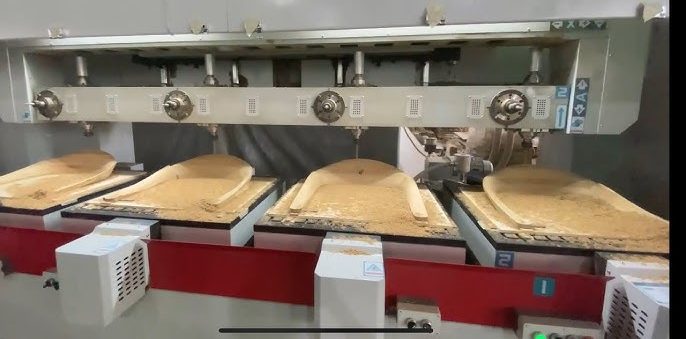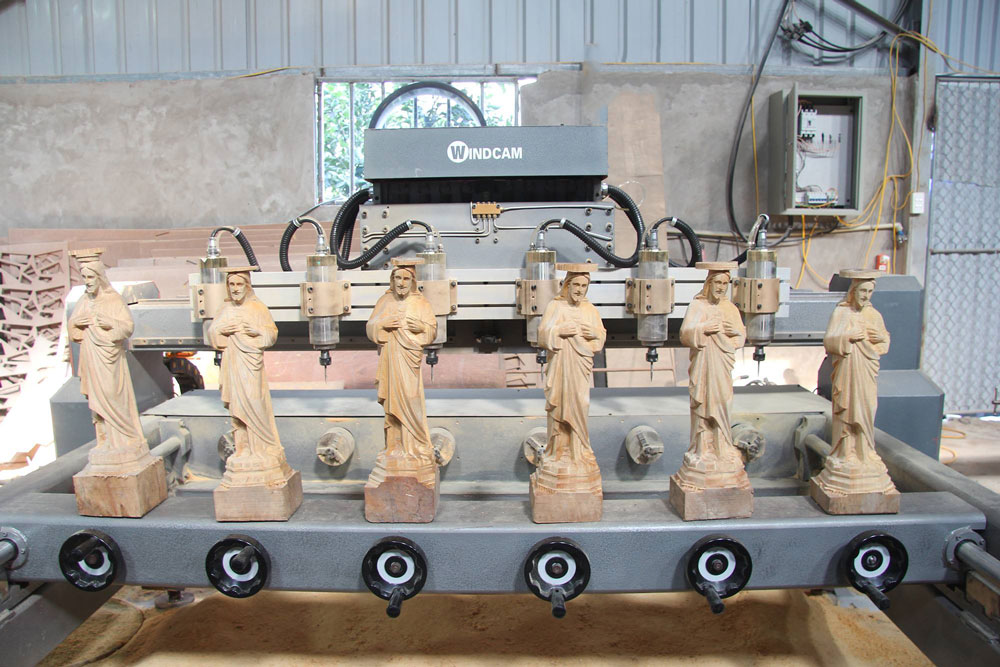Mục Lục
In the modern industrial age, custom CNC machining has become one of the important and popular manufacturing methods. It not only helps to optimize the manufacturing process but also brings flexibility and precision to the products manufactured. This article will delve into every aspect of CNC machining, from who can do it to its benefits and limitations, as well as tips that can be applied to ensure the highest efficiency.

1. CNC Processing Unit On Demand
Custom CNC machining is becoming more and more popular, not just for large manufacturers but also for anyone who needs to produce a specific product. Here are some of the people who regularly use this service, as well as the reasons why they turn to CNC machining.
1.1 Manufacturing Enterprises
Manufacturing enterprises are the main customer group in the CNC machining industry. They often need to produce precision parts in large quantities to serve their production lines. In today’s fiercely competitive environment, quality and precision are not only requirements but also decisive factors for the success of the product.
CNC machining brings high automation and consistency, helping businesses minimize errors in the production process. This not only saves time but also helps optimize production costs. Moreover, with CNC technology, the ability to produce complex and precise parts becomes easier than ever, helping businesses quickly respond to market needs.
1.2 Artisans and Designers
For artisans and designers, custom CNC machining opens up a world of limitless creativity. They can freely design unique products without being limited by traditional manufacturing methods. Using 3D design software combined with CNC machines allows them to create sophisticated works of art or decorations, thereby expressing their personal talents.
Not only that, CNC machined products are often of high quality and precision, which helps to increase the value of the product in the market. These unique designs not only attract customers but also contribute to building a strong personal brand for artisans and designers.
1.3 Startups
In the startup world, flexibility and cost savings are of utmost importance. Startups often look for manufacturing solutions that can be adjusted quickly and efficiently. Custom CNC machining is an ideal choice for them.
With the ability to produce prototypes without investing in a large production line, startups can easily test their ideas in the market. Furthermore, thanks to the flexibility of CNC machining, they can quickly adjust product designs based on customer feedback without having to change the production process.
1.4 Passionate Individuals
The “Do It Yourself” (DIY) trend is becoming more and more popular, and many creative individuals are also looking to custom CNC machining. These people often want to create products based on their own ideas without having to invest in expensive machinery or learn too much about manufacturing techniques.
Using CNC machining services, they can realize their ideas easily and quickly. This not only brings satisfaction to the individual but also helps them develop new skills and knowledge in the field of manufacturing. The combination of modern technology and personal creativity has created space for unique and impressive products.
2. Step-by-Step Guide to Custom CNC Machining
Custom CNC machining can be quite complex, but if you master each step, achieving the desired results will become easier. Below is a detailed step-by-step guide that you need to follow to be able to machine your product to your requirements.

2.1 Design Preparation Step
The first and most important step in the CNC machining process is to create a detailed design for your product. You need to use CAD (Computer Aided Design) software to draw or simulate the product.
When designing, pay attention to every detail. Make sure that all dimensions, shapes and specifications are clearly and accurately shown. Each element in the design can affect the quality of the final product. If possible, consult with experienced people or experts in the industry to ensure that your design is reasonable and feasible.
2.2 Choose the Material Type
Choosing the right material type for the product is also very important. Each type of material has its own advantages and disadvantages, affecting the function and aesthetics of the product.
You can choose from a variety of materials in CNC machining such as aluminum, steel, plastic, wood, and other composite materials. Carefully consider the intended use, working environment, and product characteristics when choosing the material. For example, if your product requires high durability, steel may be the best choice, while plastic or wood may be more suitable for lightweight or aesthetic products.
2.3 Submitting an Order to the Supplier
Once you have finalized the design and selected the material, the next step is to submit an order to the CNC machining service provider. In the order, provide complete details about the design, material type, quantity, and time required.
Clear communication with the supplier is very important to avoid unnecessary misunderstandings. If possible, ask the supplier to confirm the information before proceeding with the machining. This will help ensure that everything is done exactly as you requested.
2.4 Manufacturing Process
Once your supplier receives your order, they will begin the manufacturing process. The CNC machine will be programmed according to the design you provided. This process may include cutting, punching, or machining materials to create the finished product.
Throughout the manufacturing process, the supplier will conduct quality checks to ensure that the product meets your requirements. Keep track of the progress and ask for updates on the production status to ensure that everything is running smoothly. If any problems arise during this process, you should contact the supplier immediately for timely resolution.
2.5 Product Inspection and Finishing
Once the product is complete, you need to conduct a final quality check before putting it into use. This is an important step to ensure that the product meets all the standards you have set.
Check to see if the product meets the requirements in terms of size, shape and quality. If not, identify the problem and contact the supplier immediately to handle it. This will not only help you receive the right product, but also give the supplier the opportunity to improve the production process in the future. Once everything is inspected and finished, you can use your product with confidence, knowing that it has been manufactured with precision and quality.
3. Benefits and Limitations of Custom CNC Machining
3.1 Benefits of Custom CNC Machining
- One of the biggest benefits of CNC machining is its high precision.
- CNC machines are capable of performing cuts and machining operations with precision up to a few micrometers, which makes the product more perfect than manual machining methods. In addition, the automation process helps to minimize human errors.
- Saving time and costs is one of the main reasons why many businesses choose CNC machining.
- Because this process is automated, production time is significantly reduced, helping businesses increase productivity and profits. Moreover, with the ability to mass produce, businesses can save on operating costs.
- CNC machining also offers high flexibility.
- Users can easily change the design or adjust specifications without having to change the entire production system. This is useful for businesses that need to produce different products in the same period of time.
3.2 Limitations of Custom CNC Machining
Despite its many benefits, custom CNC machining also has certain limitations.
The initial investment cost for CNC machines and design software can be quite high. For small businesses or individuals, this can be a major barrier to accessing this technology.
Design and programming times can also be long, especially for complex products.
Without experience in using CAD software or CNC programming, it can take a long time to complete the design and preparation before proceeding with machining.
Finally, relying on machines can lead to some safety issues.
CNC machines operate at high speeds and can be dangerous if not operated properly. Workplace safety must be emphasized to ensure that employees do not encounter risks during the work process.
4. Tips for Custom CNC Machining
4.1 Choose a Reputable Supplier
Choosing a reputable CNC machining service provider is one of the factors that determine the quality of the product.
Research the supplier thoroughly before submitting an order. You can consult with previous customers or review online reviews to get an overview of the quality of their service.
4.2 Define Clear Requirements
Before submitting an order, clearly define your requirements.
Providing detailed information about the design, material and quantity will help the supplier to fulfill the request accurately. You should also discuss directly with the supplier to ensure that they understand your intentions.
4.3 Test Before Mass Production
If possible, test a sample product before mass production.
This will help you to detect any potential problems during the manufacturing process early and adjust your design or manufacturing process accordingly.
4.4 Monitoring the Manufacturing Process
One of the keys to ensuring product quality is monitoring the manufacturing process.
Ask your supplier for regular production status updates and don’t hesitate to ask questions if you feel something is wrong. This will not only give you peace of mind but also ensure that the final product is of the highest quality.
5. Risks to Watch Out for in Custom CNC Machining
Although custom CNC machining offers many benefits, there are also some risks that users need to be aware of.
5.1 Quality Risks
One of the biggest risks in CNC machining is the quality of the product not meeting the requirements.
This can be due to many reasons such as design errors, poor quality materials, or improper machining processes. To minimize this risk, you need to work closely with your supplier and regularly check the quality of the product.
5.2 Cost Risks
Although CNC machining can save costs, if not managed well, you may encounter additional costs.
For example, if the product does not meet the requirements and needs to be reworked, this can increase the cost of production. Plan carefully and always budget for possible risks.
5.3 Time Risk
In some cases, you may encounter the risk of missing production deadlines.
This can affect your project schedule and cause serious consequences. To avoid this risk, carefully negotiate with your supplier about delivery times and closely monitor the production process.
5.4 Safety Risk
Occupational safety is an important factor in any manufacturing process.
Although CNC machines are very modern, they can also cause accidents if not operated properly. Make sure that your staff is properly trained in occupational safety and has appropriate protective measures during the work process.
6. Frequently Asked Questions
6.1 What is CNC machining?
CNC machining is an automated manufacturing process using CNC machines, allowing for cutting, drilling and machining of materials with high precision.
6.2 Who can use CNC machining on demand?
CNC machining on demand can be used by manufacturing businesses, designers, startups and even DIY enthusiasts.
6.3 What are the biggest benefits of CNC machining?
The biggest benefits of CNC machining are high precision, time and cost savings, along with flexibility in design.
6.4 What are the risks of using CNC machining on demand?
There are some risks such as unsatisfactory product quality, additional costs, delayed production time and labor safety issues.
6.5 How to choose a reputable CNC machining supplier?
You can consult with previous customers, look at online reviews and request detailed quotes to compare between suppliers.


